Benefits of Local SEO in 2025
If you want your local business to thrive online, there’s no better starting point than your Google Business Profile. This powerful free tool puts your company in front of customers searching on Google Search and Maps. Whether you run a cozy café, a plumbing service, or a law firm, optimizing your profile can mean the difference between being invisible and becoming the go-to choice in your area. In this guide, I’ll walk you step by step through how to set up, optimize, and maintain your Google Business Profile for maximum local SEO visibility in 2025.
This guide is tailored for beginners, so don’t worry if you’ve never heard of citations, attributes, or NAP consistency. We’ll cover everything you need in plain English, from why your profile matters to how to keep it fresh and engaging. Ready to get found by more customers in your neighborhood? Let’s jump in.
Why Google Business Profile Matters for Local SEO
Your Google Business Profile is the first impression most customers will have of your company online. Imagine a potential customer typing “best bakery near me.” Google uses your profile data to decide if your business is shown in the coveted Local Pack – the top 3 results on Maps and Search.
The most significant Local Pack Ranking factors include the primary Google Business Profile category, keywords in the Google Business Profile title, and the proximity of address to the point of search, according to Whitespark’s latest research.
When your listing is fully optimized, you’re not just more visible – you’re more credible. A complete, well-maintained profile signals to Google that your business is active, relevant, and trustworthy. This can significantly boost your rankings, driving more clicks, calls, and foot traffic.
Let’s explore why this matters in detail.
The Impact of Google Business on Local Search Visibility
Google Business Profiles have evolved from simple directory listings to robust mini-websites packed with information. According to BrightLocal, over 90% of consumers use Google to find local businesses, and more than half of all “near me” searches lead to a visit within 24 hours.
Here’s why a complete profile improves visibility:
- Relevance: Google matches search queries to your business description, categories, and services.
- Distance: Accurate address and map pins help you appear for local searches.
- Prominence: Reviews, photos, and engagement build trust and authority.
When you combine all three factors – relevance, distance, and prominence – you’re much more likely to appear in top search results.
How Google Maps Rankings Drive Customer Engagement
Did you know that most users click on one of the top three results on Google Maps? That’s why ranking in the Local Pack is critical. A well-optimized profile encourages users to:
- Click to visit your website.
- Call you directly.
- Request directions to your storefront.
- Read reviews and see photos.
In other words, your Google Maps visibility directly fuels customer engagement. The higher you rank, the more opportunities you have to convert searches into sales. If you want to grow your local business, optimizing your Google Business Profile isn’t optional – it’s essential.
Industry-Specific Optimization Overview
Before diving into universal Google My Business tips, it’s crucial to understand that GMB ranking factors vary significantly across industries. Your local search optimization strategy should be tailored to your specific niche:
Healthcare & Medical Practices
- Patient reviews carry 40% more weight in local rankings
- Medical credentials and certifications must be prominently displayed
- HIPAA-compliant messaging and appointment booking are essential
- Hours of operation updates during emergencies significantly impact visibility
Restaurants & Food Service
- Menu photos and pricing information are critical ranking factors
- Peak hours data and wait times influence local search results
- Food delivery integration (DoorDash, Uber Eats) affects profile completeness
- Real-time capacity updates boost Google My Business performance
Home Services & Contractors
- Service area definitions dramatically impact local search reach
- License verification and insurance information are ranking signals
- Before/after project photos increase conversion rates by 60%
- Emergency service availability keywords boost visibility
Retail & E-commerce
- Product inventory status and pricing accuracy affect local rankings
- Curbside pickup and delivery options are now essential attributes
- Seasonal hours management directly impacts search visibility
- In-store pickup integration with online inventory boosts GMB performance
Professional Services (Legal, Financial, Real Estate)
- Compliance with industry regulations affects profile trustworthiness
- Professional certifications and bar admissions are crucial for credibility
- Consultation booking systems integrated with GMB improve ranking factors
- Industry-specific keywords in reviews significantly boost local search optimization
While Google dominates local search, don’t ignore other major platforms. A complete local SEO strategy requires optimization across:
- Google Business Profile (primary focus – 70% of local search traffic)
- Bing Places for Business (growing market share, especially for voice search)
- Apple Maps (crucial for iOS users and Siri recommendations)
Here’s a focused guide covering the latest tactics that are actually working for businesses this year across all these platforms.
Local SEO Best Practices That Work in 2025
These cutting-edge local SEO tactics amplify your Google Business Profile optimization and dominate 2025 local search algorithms.
AI-Optimized Website Foundation
Essential 2025 Elements:
- AI-readable structured data: LocalBusiness + FAQ schema for voice search optimization
- Conversational content: Answer questions exactly as customers ask them (“best dentist near me”)
- Core Web Vitals: Under 2.5 seconds loading speed (Google’s 2025 ranking factor)
- Mobile-first design: 85% of local searches now happen on mobile
Hyper-Local Content Strategy
What’s Working Now:
- Neighborhood-specific pages: Target micro-locations within your service area
- Real-time local content: Cover local news, events, weather impacts on your business
- Video content: Google prioritizes local business videos 3x higher in 2025
- Community involvement documentation: Photos and posts about local partnerships
Advanced Citation and NAP Strategy
2025 Citation Priorities:
- Voice search directories: Optimize for Siri, Alexa, Google Assistant results
- Industry-specific AI platforms: New AI-powered directories for healthcare, legal, home services
- Social commerce integration: TikTok Shop, Instagram Shopping with location data
- Automated consistency monitoring: Use Semrush Local or Yext for real-time updates
Multi-Platform Review Dominance
2025 Review Strategy:
- Video reviews: Encourage customers to leave video testimonials on Google
- Cross-platform review syndication: Share Google reviews to Facebook, industry sites
- AI-powered response optimization: Use tools like ReviewTrackers for response timing
- Review-rich snippets: Implement review schema for enhanced search visibility
Local Link Building 2.0
High-Impact 2025 Tactics:
- Local podcast guesting: 60% increase in local authority signals
- Community newsletter sponsorships: Local email newsletters drive strong local signals
- Local influencer partnerships: Micro-influencers in your geographic area
- Municipal website opportunities: City government, local university directories
Performance Tracking That Matters
2025 Metrics to Monitor:
- Local Pack visibility percentage: Track with BrightLocal or Moz Local
- Voice search capture rate: Monitor through Google Search Console
- Local social signals: Social media engagement from geographic area
- AI Overview appearances: New Google feature for local search results
Integration with GBP Optimization
Cross-Platform Consistency Rules:
- Identical NAP formatting: Even punctuation must match across all platforms
- Synchronized posting schedules: Coordinate Google Posts with social media
- Review response templates: Maintain consistent brand voice everywhere
- Local keyword consistency: Use same location terms across all content
These 2025 local SEO best practices work because they align with Google’s latest algorithm updates prioritizing user experience, AI-friendly content, and authentic local signals.
My Local Seo Strategy in 2025
1. Fast-Track Your Google Business Verification
Skip the lengthy manual verification process by establishing domain authority first. This method can get you automatically verified without waiting for postcards or phone calls.
Pre-Verification Setup (Do This First):
- Register your business email on your website’s domain (e.g., info@yourbusiness.com, not Gmail)
- Verify your website in Google Search Console using your domain email
- Ensure your website displays consistent NAP (Name, Address, Phone) information
- Add structured data markup to your website’s contact page
Instant Verification Method:
- Create your Google Business Profile using your verified domain email
- Google will recognize the verified domain connection and often approve instantly
- If instant verification doesn’t occur, you’ll get priority processing (usually 24-48 hours vs. weeks)
Backup Verification Options:
- Use the same domain email for all Google services (Analytics, Ads, Search Console)
- Ensure your business appears in major directories with consistent information before applying
- Have your business phone number actively monitored – Google may call for immediate verification
2. Strategic Business Name and Category Optimization
Google’s algorithms still aren’t perfect, and smart businesses exploit this by strategically including keywords in their business names and carefully selecting categories.
Business Name Keyword Strategy:
- Include your primary service keyword in your business name (e.g., “Berclys Dental Clinic” instead of just “Berclys”)
- Keep it natural – avoid obvious keyword stuffing like “Best Cheap Dentist Berclys Clinic”
- This simple change can significantly boost rankings for your target keywords
- Use the format: “Brand Name + Primary Service” for optimal results
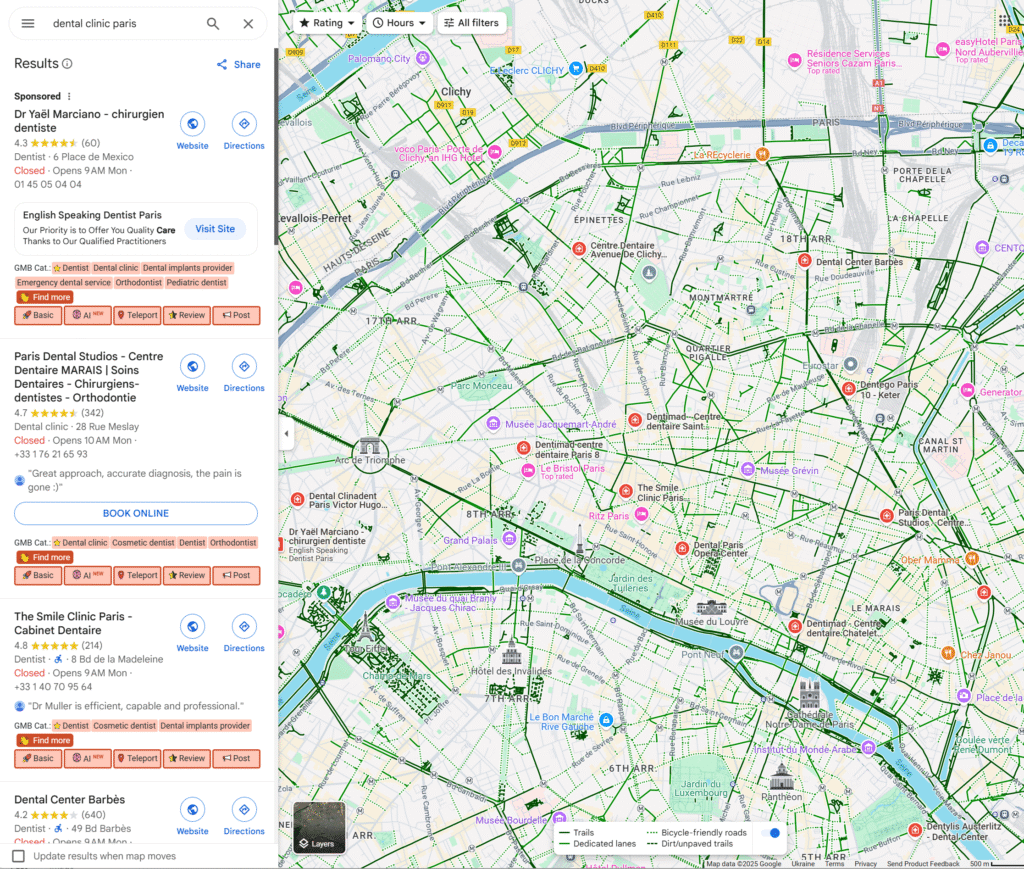
Category Selection Intelligence:
- Research your top 5 local competitors who rank well in search results
- Use these Chrome extensions to analyze competitor categories:
- GMB Everywhere – Shows Google Business Profile categories directly on Google Maps
- GMBspy – View categories for individual selected GBP listings, with ability to see top 20 search results
- PlePer Tools extension – Provides detailed listing information including all categories used when you click on a GBP listing
- Note which primary categories they use – this data reveals what Google considers most relevant
- Choose your primary category based on competitor analysis, not just what seems obvious
- Add 4-5 secondary categories that your successful competitors also use
- Avoid overly specific categories if broader ones are working better for competitors
Visual Content Strategy:
- Upload high-quality, original photos weekly (avoid stock images entirely)
- Add photos to every Google Post you create
- Use photos that show your products/services in action, not just static shots
- Include team photos and behind-the-scenes content for authenticity
3. Master Business Hours Management for Maximum Visibility
Business hours management is one of the most underestimated GMB ranking factors. Google uses hours data to determine when to show your business in local search results, making accurate hours management critical for local search optimization.
Why Business Hours Impact Rankings:
- Google prioritizes businesses that are currently open in real-time search results
- Inconsistent hours data can cause your listing to drop in rankings during peak search times
- Special hours for holidays, events, or seasonal changes signal active business management to Google
- Mobile searchers are 3x more likely to contact businesses with accurate, current hours
Strategic Hours Optimization:
Regular Hours Setup:
- Set specific hours for each day of the week, even if you’re closed
- Use 15-minute increments for precision (e.g., 9:15 AM instead of 9:00 AM)
- Include lunch breaks or midday closures if applicable to your industry
- Consider peak customer activity times when setting hours
Special Hours Management:
- Update holiday hours at least 2 weeks in advance
- Create temporary hours for special events, sales, or seasonal operations
- Use the “Temporarily Closed” feature properly during renovations or emergencies
- Set up recurring special hours for weekly events or extended weekend hours
Advanced Hours Strategies:
- Monitor Google Business Profile Insights to identify peak customer activity times
- Adjust hours based on seasonal demand patterns in your industry
- Use different hours for different services (e.g., restaurant vs. bar hours)
- Implement “by appointment only” hours for service-based businesses
Hours Management Tools:
- Google My Business app – Set up mobile notifications for hours changes
- Hootsuite – Schedule hours updates in advance
- Yext – Automate hours updates across multiple platforms
- BirdEye – Monitor hours consistency across all local directories
4. Optimize Google Posts with Strategic CTAs
Publish weekly Google Posts that link to blog posts, products, categories, Q&A, events, or offers. The key is consistency and strategic linking.
Weekly Posting Strategy:
- Monday: Product/service highlights with direct purchase links
- Wednesday: Educational content linking to blog posts
- Friday: Special offers or events with clear CTAs
- Repurpose existing content from other platforms to maintain consistency
5. Implement the New WhatsApp Integration
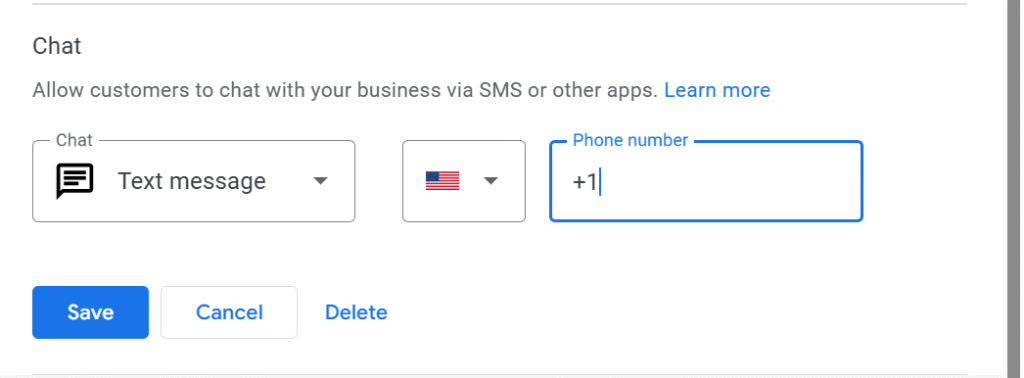
Google has introduced a new feature for Google Business Profiles that allows businesses to add a WhatsApp contact on GBP, enabling direct customer communication.
Setup Process:
- Add your business WhatsApp number in the contact section
- Set up automated welcome messages
- Ensure your WhatsApp Business account is professionally configured
- Monitor and respond to messages within 2 hours for optimal engagement signals
6. Master Review Management – Your Ranking Power Tool
Reviews are one of the most critical GMB ranking factors. Google’s algorithm uses review signals to determine local search rankings: quantity, quality, recency, and response rates all directly impact your visibility.
Why Reviews Matter for Rankings:
- Review velocity (consistent new reviews) signals business activity to Google
- Review response rate is a direct ranking factor – businesses with 90%+ response rates rank higher
- Keywords in reviews help Google understand what services you provide
- Star rating threshold matters – businesses below 4.0 stars struggle to rank on page 1
Strategic Review Response Framework:
For Positive Reviews:
- Respond within 12 hours maximum
- Include 2-3 relevant keywords naturally (e.g., “Thank you for choosing our dental cleaning services”)
- Mention specific services the customer used
- Add a call-to-action for future visits
- Example: “Thanks for the great review about our teeth whitening service! We’re glad you loved the results. Looking forward to your next cleaning appointment!”
For Negative Reviews:
- Respond professionally within 6 hours
- Acknowledge the specific issue mentioned
- Include service keywords while addressing concerns
- Offer to resolve offline
- Example: “We apologize for the issues with your dental appointment scheduling. We’d like to make this right – please call us at [number] so we can discuss your root canal treatment concerns directly.”
Review Generation Strategy:
- Ask for reviews immediately after positive service interactions
- Send follow-up emails 24-48 hours after service completion
- Focus on authentic review generation – Google’s AI detects fake patterns easily
- Target 2-4 new reviews per month for sustainable growth
7. Google Business Profile Insights: Data-Driven Local SEO Optimization
Google Business Profile Insights provides critical data about how customers find and interact with your business. Understanding this analytics data is essential for refining your local SEO strategy and content optimization.
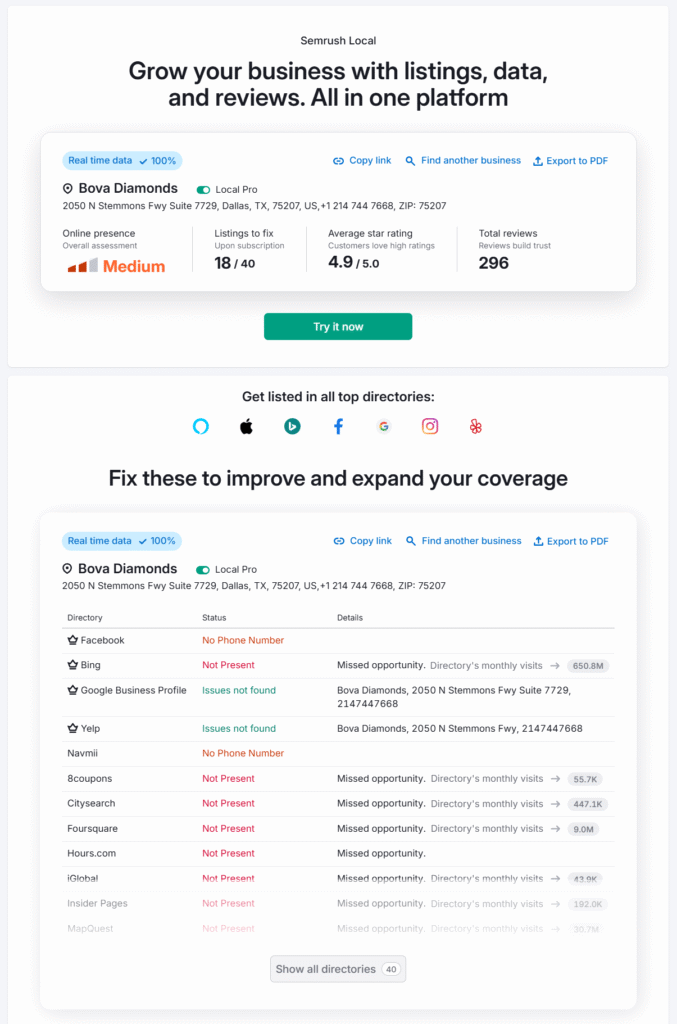
How to Use Insights for Strategic Optimization:
- Analyze which search queries generate the most profile views – these reveal your strongest keyword opportunities
- Identify geographic areas where you get the most visibility to focus local marketing efforts
- Track which customer actions (website visits, calls, direction requests) convert best from specific keywords
- Monitor seasonal trends in search queries to plan content calendar and service promotions
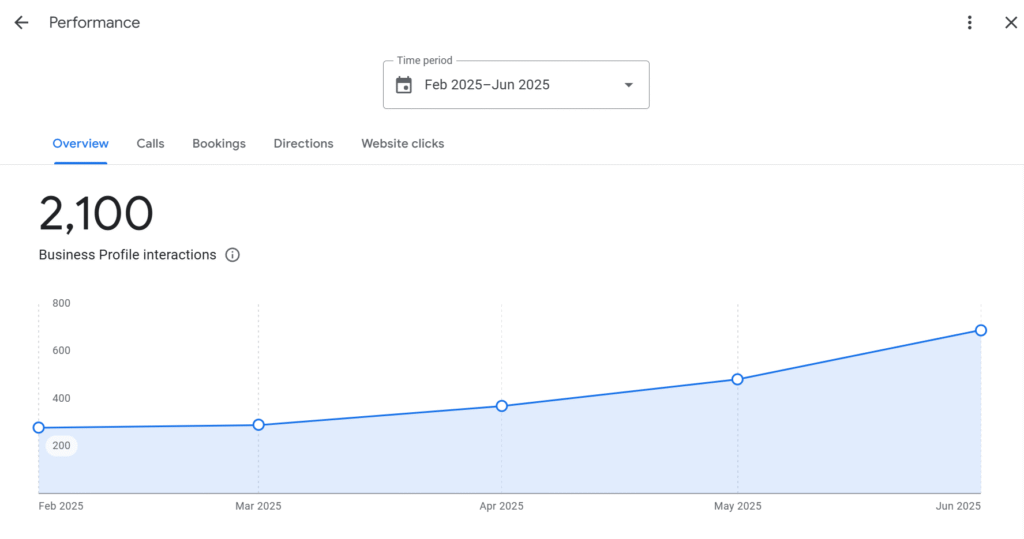
Key Google Business Profile Metrics to Track:
- Search query performance – which keywords drive profile views vs. website clicks
- Discovery methods – whether customers find you through direct searches, discovery searches, or Maps browsing
- Customer action patterns – what visitors do after viewing your profile (call, visit website, get directions)
- Post engagement analytics – which content types generate the most customer actions
- Photo performance data – which images drive the most profile engagement
Advanced Analytics with Professional Tools:
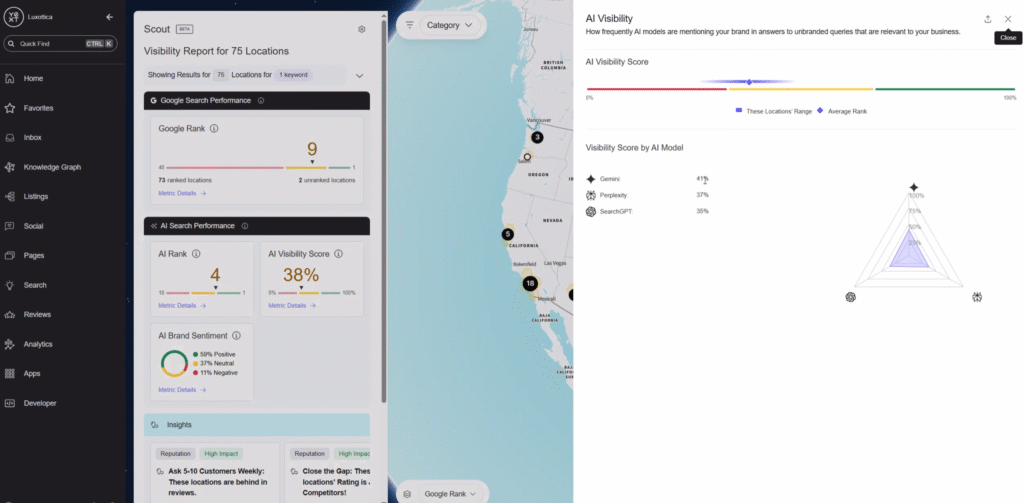
For deeper insights beyond Google’s native analytics, consider these enterprise-level platforms:
- Yext Analytics – Cross-platform visibility tracking and advanced keyword analysis
- Uberall Insights – Multi-location performance tracking with competitor benchmarking
- Rio SEO – Enterprise local search analytics with ROI tracking
- BirdEye – Comprehensive reputation and listing performance analytics
These tools provide insights not available through Google directly, including competitor analysis, cross-platform performance tracking, and advanced keyword attribution data.tform performance tracking, and advanced keyword attribution data.
8. Build Local SEO Citations and NAP Consistency for Ranking Power
Local SEO citations directly influence local search rankings through consistent NAP information across multiple platforms. Google uses NAPs to confirm that all of your business info is correct, and accounting for nearly 10% of local ranking factors, local citations can be an easy win.
How Local SEO Citations Impact Your Google Business Rankings:
- Recent data shows businesses with 40+ accurate citations rank 53% higher in local search
- Each consistent NAP mention acts as a “vote of confidence” for your business legitimacy
- Links from citation sources pass authority to your Google Business Profile
- Citations signal to Google that your business is relevant and legitimate, improving your ranking with Google’s local algorithm
Strategic Citation Building Process:
Phase 1: Major Directories (Do These First)
- Google Business Profile (obviously)
- Bing Places
- Yelp, Facebook Business, Apple Maps
- Industry-specific directories (e.g., Healthgrades for medical, Avvo for legal)
- Local chamber of commerce websites
Phase 2: Tier-2 General Directories
- Yellow Pages (YP.com)
- Superpages
- White Pages
- MapQuest
- Hotfrog
- Brownbook
- Cylex
- Ezlocal
Phase 3: Industry-Specific Citations
For Restaurants:
- Zomato
- OpenTable
- Grubhub
- DoorDash
- TripAdvisor
- Urbanspoon
For Healthcare:
- Healthgrades
- Vitals
- WebMD
- Zocdoc
- RateMDs
- Sharecare
For Legal Services:
- Avvo
- Justia
- FindLaw
- Lawyers.com
- Martindale-Hubbell
For Home Services:
- Angie’s List (Angi)
- HomeAdvisor
- Thumbtack
- Porch
- Houzz
- Better Business Bureau
For Automotive:
- Cars.com
- AutoTrader
- Carfax
- Edmunds
- DealerRater
Phase 4: Local and Regional Citations
- Local newspaper websites
- City government business directories
- Local chamber of commerce sites
- Regional business journals
- Local event listing sites
- Neighborhood association websites
- Local university business directories
- Regional tourism websites
Phase 5: Automated Citation Building

Use these services to scale your citation building:
- Semrush Local Listings – Comprehensive audit and automated submissions to 100+ directories
- Yext – Premium option for enterprise-level citation management and real-time updates
- BrightLocal – Citation building and monitoring with detailed reporting
- Whitespark – Specialized in local citation building with manual verification
NAP Consistency Rules:
- Use identical formatting across all platforms (don’t mix “Street” and “St.”)
- Keep phone numbers in the same format (xxx-xxx-xxxx vs (xxx) xxx-xxxx)
- Use the same business name variation everywhere
- Ensure your website URL is consistent (with or without www)
Advanced Citation Strategy:
- Target local news websites and blogs for mentions
- Get listed in local business associations
- Partner with other local businesses for cross-citations
- Monitor and fix inconsistent citations monthly using citation audit tools
- Create location-specific citations for multi-location businesses
- Build citations in local supplier and vendor directories
- Seek citations from local event sponsorships
- Get featured in local “best of” lists and awards
Citation Monitoring and Maintenance:
- Monthly citation audits using tools like Moz Local or BrightLocal
- Set up Google Alerts for your business name and address
- Monitor review sites for duplicate or incorrect listings
- Track citation building progress with spreadsheets or dedicated tools
- Address citation discrepancies immediately when found
- Update citations when business information changes
9. Optimize for Local AI Search Features
With AI Overviews becoming more prominent, your GBP needs to provide clear, direct answers to common customer questions.
Implementation Strategy:
- Update your business description with natural language that answers “what,” “where,” and “when” questions
- Use the Q&A section proactively – add 10-15 common questions and detailed answers
- Include service-specific keywords in your posts and descriptions
- Ensure your hours, services, and contact information are always current
10. Demonstrate E-E-A-T in Your Google Business Profile
Google’s updated E-E-A-T guidelines now emphasize “Experience” as a critical ranking factor for local businesses. Your Google Business Profile must clearly demonstrate real-world expertise and trustworthiness. For a step-by-step walkthrough on how to track your Google Business Profile performance with UTM parameters, check out this detailed guide.
Building Experience and Expertise Signals
Optimize Your Business Description:
- Lead with specific qualifications and years of experience
- Example: “Board-certified dermatologist with 12+ years serving Denver families, 2,500+ successful procedures completed”
- Include professional certifications, degrees, and specialized training
- Mention specific numbers: clients served, projects completed, awards received
Strategic Photo and Content Strategy:
- Upload photos of certifications, diplomas, and professional awards
- Share behind-the-scenes photos showing your team and workspace
- Post educational content demonstrating industry knowledge
- Include images of professional equipment and ongoing training
Building Authority and Trust
Q&A Section Optimization:
- Add 15-20 detailed questions and answers showcasing expertise
- Use technical accuracy and industry-specific terminology
- Reference industry standards and best practices
- Update monthly with new industry-relevant questions
Review Management for E-E-A-T:
- Respond to all reviews within 12 hours professionally
- Address concerns with specific solutions and expertise
- Encourage customers to mention specific services in reviews
- Share success stories in Google Posts (with permission)
Professional Content Strategy:
- Post about industry certifications and continuing education
- Share updates about new techniques or equipment
- Reference partnerships with established brands
- Maintain consistent, professional communication across all content
Quick Implementation Checklist
Week 1: Foundation
- Rewrite business description emphasizing credentials
- Upload certification and award photos
- Create initial Q&A entries
Week 2-4: Content Development
- Develop educational Google Posts
- Ensure all business information is accurate and current
- Establish professional review response system
Ongoing: Authority Building
- Publish weekly educational content
- Track expertise-related search terms in GBP Insights
- Monitor review sentiment for professionalism mentions
- Update Q&A section monthly
E-E-A-T optimization is ongoing. Consistent demonstration of expertise through regular content updates and professional engagement will significantly improve your local search visibility and customer trust over time.
Local SEO Checklist: My Google Business Profile Success Roadmap
Now that you have all the strategies, here’s your realistic implementation timeline to avoid overwhelm and ensure sustainable results:
Week 1-2: Foundation Setup
- Complete domain-based verification process
- Optimize business name with strategic keywords
- Research and set primary + secondary categories using competitor analysis
- Set up WhatsApp integration
Week 3-4: Content and Visual Strategy
- Upload 10-15 high-quality, original photos
- Create your first 4 Google Posts with strategic CTAs
- Set up review response system and templates
- Begin building citations on major directories
Month 2: Automation and Scaling
- Implement automated citation building with Semrush Local Listings or Yext
- Set up weekly posting schedule using your content calendar
- Start monitoring Google Business Profile Insights weekly
- Establish review generation process
Month 3+: Advanced Optimization
- Analyze competitor strategies using Chrome extensions
- Refine keyword strategy based on Insights data
- Expand to Bing Places and Apple Maps optimization
- Consider professional analytics tools for multi-location businesses
Success Metrics to Track:
- Profile views increase of 40-60% within 90 days
- 15-25% improvement in “actions taken” (calls, directions, website visits)
- Consistent 2-4 new reviews monthly
- Ranking improvements for primary local keywords
Download Excel Roadmap for GBP Optimization for free:
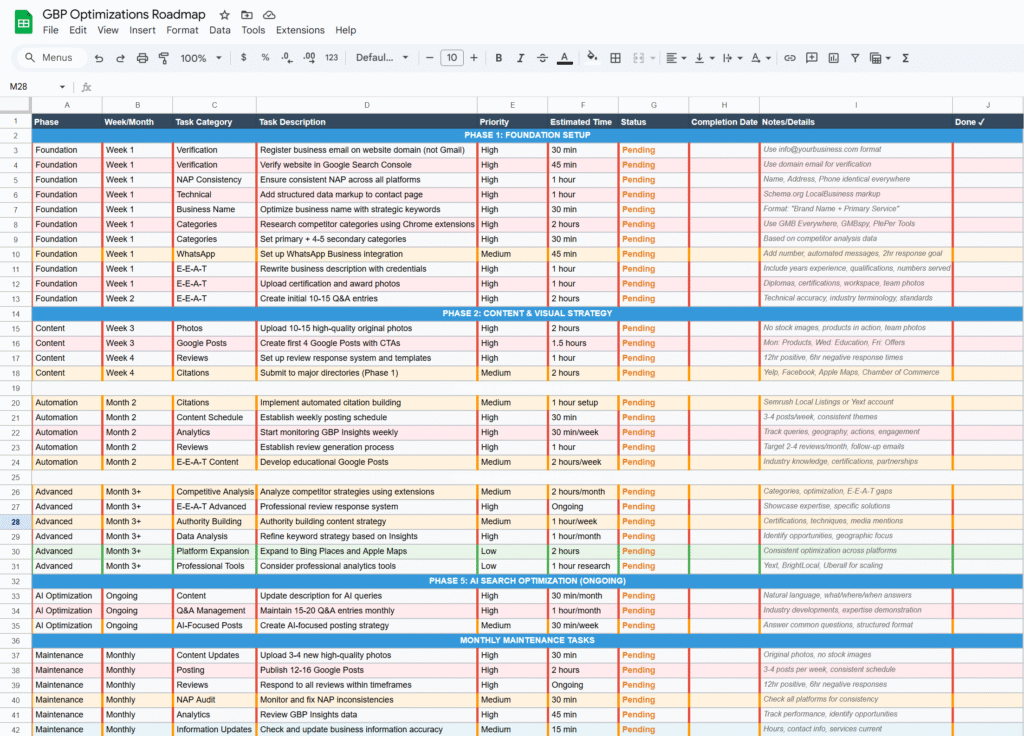
📊 https://docs.google.com/spreadsheets/d/1qJIUw1iRLswT7Gx-iHFgRRLEovAub6Ee1RFjMZ5M4bE/edit?usp=sharing
The businesses dominating local search in 2025 treat Google Business Profile as their primary customer acquisition channel, not just a directory listing. Your consistent effort over the next 90 days will compound into significant visibility gains.
Remember: Start with verification and categories this week. Everything else can be built systematically. The key is beginning now, not perfecting everything before you start.
My References:
- 1. Google Business Profile Help – Tips to improve local ranking (2025) https://support.google.com/business/answer/7091?hl=en
- 2. Backlinko – 24 Must-Know Local SEO Statistics for 2025 (May 2025) https://backlinko.com/local-seo-stats
- 3. BrightLocal – 31 Local SEO Statistics You Need for 2025 (February 2025) https://www.brightlocal.com/resources/local-seo-statistics/
- 4. BrightLocal – Google’s Local Algorithm and Local Ranking Factors (February 2025) https://www.brightlocal.com/learn/local-seo/introduction-to-local-seo/ranking-factors/
- 5. BrightLocal – Local SEO Checklist Updated for 2025 (April 2025) https://www.brightlocal.com/learn/local-seo/management/checklist/
- 6. Uberall – Key Local SEO Ranking Factors for 2025: From The Experts (March 2025) https://uberall.com/en-us/resources/blog/google-ranking-factors-to-watch
- 7. Whitespark – 2023 Local Search Ranking Factors Report (2023) https://whitespark.ca/local-search-ranking-factors
- 8. Whitespark – Review Recency is the Most Underrated Local Ranking Factor in 2025 https://whitespark.ca/blog/the-most-underrated-local-ranking-factor-in-2025/
- 9. Search Engine Land – 2023 Survey: Local search ranking factors (March 2023) https://searchengineland.com/2023-survey-local-search-ranking-factors-394839
- 10. Relevant Audience – Top Local SEO Ranking Factors for 2025 https://www.relevantaudience.com/top-local-seo-ranking-factors-for-2025/
- 11. BizIQ – Top Local SEO Ranking Factors for 2025 (March 2025) https://biziq.com/blog/top-local-seo-ranking-factors-for-2025/
- 12. Link Assistant – Local SEO Ranking Factors 2024 (Entity-based Approach) (March 2025) https://www.link-assistant.com/news/local-seo-factors.html
Is a senior SEO expert with over a decade of experience dominating the digital marketing battlefield. Since 2023, I’ve been riding the AI wave. Since 2024, I have started to work with the SEO Bazooka Blog.

Leave a Reply